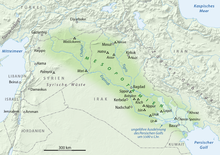Uruk period
 |
|
| Geographical range | Mesopotamia |
|---|---|
| Period | Copper Age |
| Dates | c. 4000–3100 BC |
| Type site | Uruk |
| Preceded by | Ubaid period |
| Followed by | Jemdet Nasr period |
The Uruk period (ca. 4000 to 3100 BC) existed from the protohistoric Chalcolithic to Early Bronze Age period in the history of Mesopotamia, following the Ubaid period and succeeded by the Jemdet Nasr period. Named after the Sumerian city of Uruk, this period saw the emergence of urban life in Mesopotamia. It was followed by the Sumerian civilization. The late Uruk period, (34th to 32nd centuries) saw the gradual emergence of the cuneiform script and corresponds to the Early Bronze Age; it may also be called the Protoliterate period. It was during this period that pottery painting declined as copper started to become popular, along with cylinder seals.
The term Uruk period was coined at a conference in Baghdad in 1930, where at the same time the Jemdet Nasr and Ubaid periods were defined.
Periodization is after archaeological layers at Uruk. Thus, Uruk XVIII–XIV are not part of the "Uruk period" proper but are comprised by the Ubaid period. The Uruk period proper corresponds to the layers Uruk XIV–IV, with the late phase Uruk IV lasting ca. 3300–3100 BC. Uruk III reaches up to 3000 BC and into the Early Dynastic period . [source needed]
Around 3600 BCE, during the Middle Uruk period, Uruk trade networks started to expand to other parts of Mesopotamia, and as far as North Caucasus.
According to Konstantine Pitskhelauri, this expansion started even earlier, at the end of the 5th millennium BC, and continued in the 4th millennium. Large masses of Uruk migrants had settled in the South, and later in the North Caucasus.
The sites in this general area include Habuba Kabira in Syria, and Arslantepe in Turkey.
...
Wikipedia
